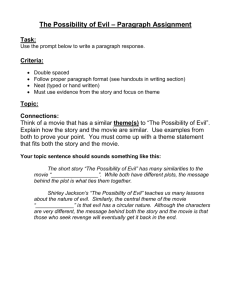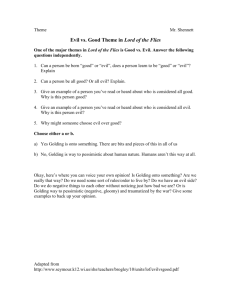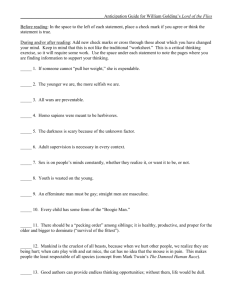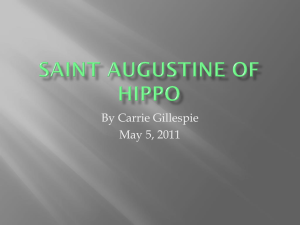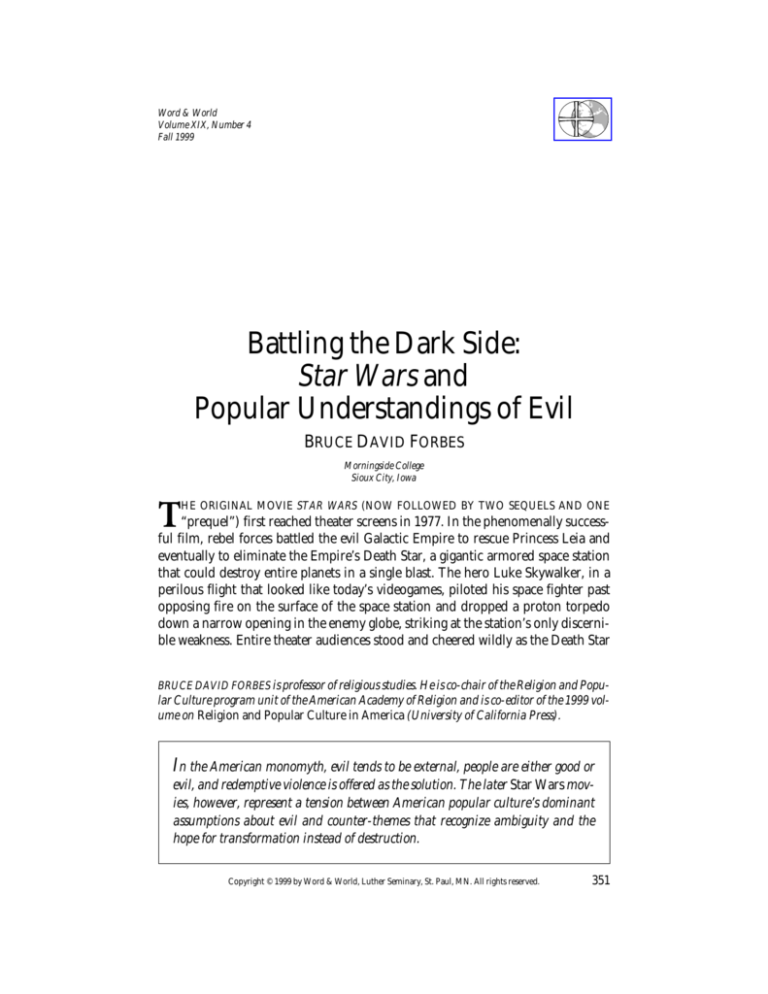
Word & World
Volume XIX, Number 4
Fall 1999
Battling the Dark Side:
Star Wars and
Popular Understandings of Evil
BRUCE DAVID FORBES
Morningside College
Sioux City, Iowa
HE ORIGINAL MOVIE STAR WARS (NOW FOLLOWED BY TWO SEQUELS AND ONE
“prequel”) first reached theater screens in 1977. In the phenomenally successful film, rebel forces battled the evil Galactic Empire to rescue Princess Leia and
eventually to eliminate the Empire’s Death Star, a gigantic armored space station
that could destroy entire planets in a single blast. The hero Luke Skywalker, in a
perilous flight that looked like today’s videogames, piloted his space fighter past
opposing fire on the surface of the space station and dropped a proton torpedo
down a narrow opening in the enemy globe, striking at the station’s only discernible weakness. Entire theater audiences stood and cheered wildly as the Death Star
BRUCE DAVID FORBES is professor of religious studies. He is co-chair of the Religion and Popular Culture program unit of the American Academy of Religion and is co-editor of the 1999 volume on Religion and Popular Culture in America (University of California Press).
In the American monomyth, evil tends to be external, people are either good or
evil, and redemptive violence is offered as the solution. The later Star Wars movies, however, represent a tension between American popular culture’s dominant
assumptions about evil and counter-themes that recognize ambiguity and the
hope for transformation instead of destruction.
Copyright © 1999 by Word & World, Luther Seminary, St. Paul, MN. All rights reserved.
351
Forbes
exploded in a cosmic fireworks display. Having had their fill of ambiguous movies
with unresolved endings, the public resonated with a portrayal of clear-cut good
and evil. Here, as in the old westerns and in superhero comic books, the good guys
won, evil was destroyed, and we could feel satisfied by the victory.
Reflections on the nature and source of evil, and our mode of deliverance, are
expected from theologians and preachers. Yet the cogency of these reflections is enhanced if we are aware of the assumptions and convictions already held by people
in the pew and even more generally, members of the wider public. What are the
common public perceptions of evil? How can we learn what they are, especially
when many persons are not consciously aware of all their assumptions or not very
articulate in expressing them? Social surveys or polling data are one option, but not
much is available.1 We also could rely on anecdotes from friends, relatives, and parishioners. A third option, the focus of this article, is the analysis of popular culture, with Star Wars serving as a major example.
Recent years have seen an explosion of scholarly interest in the examination
of popular culture, and most of the analysis is undergirded by a basic principle:
popular culture both reflects us and shapes us. On one hand, examining what is
popular tells us about society. It is like holding up a mirror to see ourselves. The
public decides what movies, television shows, music, and clothing styles become
popular, sometimes surprising the pundits. What we choose must resonate with us
in some way, thus revealing our fears, hopes, yearnings, or assumptions. It is an admittedly speculative task to figure out what those are, but widespread patterns in
popular culture can give us clues. On the other hand, popular culture also shapes
us, reinforcing certain attitudes and beliefs and revising others through repetitious
messages. Thus, for example, when people argue about whether violence in the
mass media helps create a violent society or reflects a society that is already violent,
the answer is, both.2
To see both the reflections of ourselves and the shaping influences, it is most
helpful to focus on very broad patterns within popular culture and on “blockbuster” examples that have been embraced by an overwhelming portion of the
population. The following discussion looks at popular culture in an attempt to discern some common understandings of evil. First, we will consider two key theoretical approaches to popular culture that will help us think in very broad strokes
about widespread patterns in movies, television programs, and more. Then, secondly, we will discuss the Star Wars movies as significant examples within the culture that may illustrate and challenge these patterns.
1For example, the Gallup Poll and the Princeton Religion Research Center annually ask about public belief
in God, but they ask about belief in the devil more infrequently. In 1994 65% of respondents answered yes when
asked “Do you believe in the devil?” but no other accompanying questions help us understand how literal or symbolic those beliefs might be. George H. Gallup Jr., Religion in America 1996 (Princeton, NJ: Princeton Religion Research Center, 1996) 20, 22.
2These principles for the analysis of popular culture are discussed more fully in my introductory chapter,
“Finding Religion in Unexpected Places,” in Religion and Popular Culture in America, ed. Bruce David Forbes and
Jeffrey H. Mahan (Berkeley: University of California Press, 1999) 1-20.
352
Battling the Dark Side
I. AMERICAN POPULAR CULTURE
We begin with two classic interpretations of American popular culture that
can provide a helpful framework for understanding broad patterns.
1. John Wiley Nelson. The first author is John Wiley Nelson, a professor of
theology at Pittsburgh Theological Seminary who published Your God is Alive and
Well and Appearing in Popular Culture in 1976.3 One of his central claims was that
there exists, alongside the traditional religions that many people acknowledge, an
“American cultural religion.” “Functioning societies in their most stable periods of
self-understanding and expression,” he wrote, “produce a single dominant set of
values which unifies all the shared individual or small-group beliefs into one characteristic belief system.”4 That dominant set of values is the basis of an American
cultural religion. This claim about the existence of an unrecognized societal “religion” that is distinct from traditional institutionalized religions is similar to the thesis of Robert Bellah’s famous essay on “Civil Religion in America,” written nine
years earlier.5
What made Nelson’s discussion different from Bellah’s was Nelson’s focus
upon popular culture, such as television, films, music, and popular literature, as the
expression and reaffirmation of the American cultural belief system. Traditional religious institutions are explicit in stating what they believe and “in scheduling the ritual dramas of reaffirmation, that is, the worship services. American cultural religion
is much less recognizably explicit, but no less powerfully pervasive in our lives.”6 For
Nelson, popular culture, such as watching television in the family room of a suburban home, is the worship experience for the American cultural religion.
In the worship ritual all that is affirmed in the religion is integrated in a dramatic
style, explicitly designed to more firmly establish the foundation of life-meaning
advocated by the religion. The same case can be made for popular culture in
America....Popular culture is to what most Americans believe as worship services
are to what the members of institutional religions believe. That, in a nutshell, is our
thesis.7
To discern the creed of the American cultural religion, which usually is implicit rather than explicit in popular culture, Nelson provided a template of basic
beliefs that could be teased out of most popular cultural examples. “A belief system
3John Wiley Nelson, Your God is Alive and Well and Appearing in Popular Culture (Philadelphia: Westminster, 1976).
4Ibid., 19.
5Robert N. Bellah, “Civil Religion in America,” Daedalus: Journal of the American Academy of Arts and Sciences 96/1 (1967) 1-21. Bellah’s thesis statement is found in the opening paragraph of the essay: “While some have
argued that Christianity is the national faith, and others that church and synagogue celebrate only the generalized
religion of ‘the American Way of Life,’ few have realized that there actually exists alongside of and rather clearly differentiated from the churches an elaborate and well-institutionalized civil religion in America. This article argues
not only that there is such a thing, but also that this religion—or perhaps better, this religious dimension—has its
own seriousness and integrity and requires the same care in understanding that any other religion does” (1).
6Nelson, Your God Is Alive, 19.
7Ibid., 16.
353
Forbes
is a systematically arranged set of answers to basic life-problem questions,” and
Nelson organized the answers in five categories:
1. shared views of what is unsatisfactory about present experience
2. shared views about the source of that unsatisfactory situation
3. shared views of the nature of the delivering force through which the source
of evil is defeated
4. shared views of what a resolved situation would look like
5. shared views of the “Way,” or the path to follow, to this perfection, if such a
catechism is necessary.8
The first two categories in the list are, in traditional Christian theological language,
beliefs about the nature and the source of evil, which is our special concern in this essay.
When Nelson moved to a discussion of films he focused on the classic western, which he called the “high mass” of the American cultural religion, because it
communicated so effectively the society’s dominant belief system. (Keep in mind
that he wrote in the 1970s, reflecting upon the western’s dominance in television
series and movies over the previous two decades.) However, in outlining the form
and content of a western, with a hero-deliverer, sidekick, villains, townspeople, and
a setting “on the edge of the conflict between civilization and savagery,” he noted
that all westerns do not have to be set in the frontier period of the American West.
His chapter on westerns discussed two films in detail, Shane and Casablanca, maintaining that the latter also was a western in form even though it took place in North
Africa in the twentieth century.9 However, Nelson did not claim that all movies or
television programs were westerns. He recognized that many examples challenged
the dominant form and the dominant beliefs, and he called these anti-westerns,
which were skeptical about assumptions of the dominant belief system, finding
them to be untrue, naive, or self-serving. At the time of his writing Nelson had witnessed a rise of the anti-western, but he thought he detected signs of a public return
to the dominant pattern.10
Regarding the nature and the source of evil, what did Nelson find in the western and throughout popular culture? The sources of threat or evil could be many.
Families might be “beset by extramarital sex, honky-tonks, or bad companions, or
overwhelmed by disease or an unscrupulous landlord.” Communities could be
threatened by criminal elements, and nations might be threatened by foreign armies or alien ideologies.11 Yet one very important characteristic was shared by all of
these examples.
However diverse, all these sources have one thing in common: they are all exter8Ibid.,
20-21.
9Ibid., chapter 2. Nelson’s interpretation of the western genre was heavily dependent upon John G. Cawelti’s
The Six-Gun Mystique (Bowling Green, OH: Bowling Green Popular University Press, 1970).
10Nelson, Your God Is Alive, chapter 3.
11Ibid., 21.
354
Battling the Dark Side
nal to the community, or to the group within the community that they attack....The people who are having the problem are not themselves responsible
for it. They are, in a word, innocent and hence basically good. They may be impotent or afraid, but they are guilty of nothing more. Their deliverance frees
them to live not a transformed life, but the naturally good life they would have
lived had nothing previously intervened....[T]he externality of evil remains a
consistent characteristic of the American belief system.12
2. Robert Jewett and John Shelton Lawrence. Alongside Nelson’s significant
discussion, a second now classic work of popular culture interpretation appeared
only a year later: The American Monomyth, by Robert Jewett and John Shelton
Lawrence, religious studies and philosophy professors at Morningside College.13
Many elements of their thesis are compatible with Nelson’s views, but their work
was essentially completed before the appearance of Nelson’s work and they made
no reference to it. They discussed a similar dominant pattern in popular culture
but extended it beyond the western.
Jewett and Lawrence were aware of Joseph Campbell’s studies of myths, in
which he found a single recurrent pattern in traditional mythological storylines. In
The Hero with a Thousand Faces, Campbell summarized the plot of the classical
monomyth as follows:
A hero ventures forth from the world of common day into a region of supernatural wonder: fabulous forces are there encountered and a decisive victory is won:
the hero comes back from this mysterious adventure with the power to bestow
boons on his fellow man.14
Campbell, and Jewett and Lawrence, could see this plot in traditional tales about
Prometheus or Ulysses or St. George and the dragon or Hansel and Gretel. Yet when
Jewett and Lawrence surveyed American popular culture they became convinced
that this plot did not describe most of what they saw. They could detect a common
plot or storyline, but it was different from the classical one. They contend that a distinctively American monomyth has emerged, summarized in this way:
A community in a harmonious paradise is threatened by evil: normal institutions fail to contend with this threat: a selfless superhero emerges to renounce
temptations and carry out the redemptive task: aided by fate, his decisive victory
restores the community to its paradisal condition: the superhero then recedes
into obscurity.15
This singular plot summary sounds very much like a western, and it is no surprise for
Jewett and Lawrence, who trace its development through Indian captivity narra12Ibid.,
21-22.
13Robert Jewett and John Shelton Lawrence, The American Monomyth (Garden City, NY: Anchor/Double-
day, 1977).
14Joseph Campbell, The Hero with a Thousand Faces (New York: Meridian, 1956) 30. Also quoted in Jewett
and Lawrence, American Monomyth, xix.
15Jewett and Lawrence, American Monomyth, xx.
355
Forbes
tives, pulp fiction, westerns, and comic book superheroes. One other influence is
significant in the development of the American monomyth: the Judeo-Christian
tradition. The classical monomyth is a tale of initiation, they note, but the American
monomyth is a tale of redemption. The superhero is a savior or a deliverer, and the
familiarity of this storyline might be expected in a national culture with substantial
Christian background.
Jewett and Lawrence offered several evaluations of this dominant monomythic pattern in American popular culture. They asked how the dominant plot
structure involving superhuman redemption fits with claims about the secularization of American society. They worried that the helplessness of the community and
the reliance on a superhero tend to undercut democracy. When the deliverer triumphs over evil and then withdraws, how is the community any better prepared to
cope with the next threat when it arises? They were concerned that cultural messages about reliance on extralegal superheroes contained potential seeds for fascism.
II. EVIL IN POPULAR CULTURE
When viewing popular culture through the interpretive lenses provided by
Nelson, Jewett, and Lawrence, concerns also might be raised about understandings
of evil. Three interrelated assumptions emerge from the dominant story lines in
American popular culture:
1. The externality of evil. The evil threat usually comes from the outside and
threatens an innocent community. In westerns, the townspeople are terrorized by
an outlaw gang that rides in and takes over the town, or the menace might be a corrupt banker who lives in the town but is not really part of the community. In James
Bond films, Agent 007 saves the world from villains like Goldfinger, or Russian
rogue forces, or in the recent Austin Powers spoofs of such spy movies, Dr. Evil.
Even Disney animated films feature external dangers: in the movie Aladdin, the
scheming Jafar has manipulated his way into the Sultan’s court, but he is clearly an
outsider, in appearance, loyalties, and character. When applied to our psychological and spiritual self-understandings, the received message from this emphasis
upon external evil is that the basic problem is not us, and that we are not in need of
an essential transformation, even though there are things we could change and improve.
2. The dualistic evaluation of persons as good or evil. A correlate of these assumptions about an innocent community and evil external threats is that there is a
clear-cut distinction between good and evil, and people are either one or the other.
The contrast to this view would be a perspective that sees people as mixed, with admirable qualities and deeply tragic failings in the same person. Old westerns like
the Lone Ranger, with characters in white hats and black hats, did not admit such
ambiguity. Neither do the battles between Superman and Lex Luthor, or conflicts
between Simba and his envious Uncle Scar in Disney’s The Lion King. People may
356
Battling the Dark Side
protest that most of these examples are really cartoons, in the broadest sense, with
overly simple portrayals of good and evil that are suitable for the understandings of
children. Yet the pattern persists in action-adventure television series and movies
marketed to adults, in horror movies, and in many examples of science fiction.
(Consider the plots in Rocky or Rambo movies, the Walker, Texas Ranger television series, or the two Scream movies.) The common story line in ancient Greek
tragedies, in contrast, explored the hubris within the stories’ heroes or main characters. In the dominant pattern in American popular culture, people are either
good or evil instead of being both good and evil.
By the way, movies and television shows that feature government conspiracies or betrayals by trusted friends do not necessarily contradict this pattern of seeing clear-cut distinctions between good and evil persons. Even though evil figures
can deceive others and appear good for a time, their essential character is still evil,
only temporarily hidden by their deception and manipulation which is, in the final
analysis, further evidence of their depravity.
3. Redemptive violence as the solution. Quite simply, if something or someone
is purely evil, the appropriate resolution is to eliminate it, to destroy it. Violence,
then, can be perceived as redemptive and purgative.16 In contrast, those who see
people as simultaneously “saint and sinner” might be inclined to seek transformation rather than destruction. Jewett and Lawrence did not claim that the hero’s decisive victory in the American monomythic pattern is always accomplished
through violence, but it often is. In westerns, in Disney animated movies, in spy
thrillers, in horror movies, in action-adventures of all kinds, how many times is the
enemy, the source of threat or danger, transformed into a contributing member of
the community? In how many cases is the person eliminated? In most cases it is the
latter, deriving from the assumption that the enemy, unmixed evil, is not redeemable.
I will leave a Christian theological critique of these three assumptions to others, but I would assume that major questions would be raised about the theological
and ethical validity of all three.17 It is easy, however, to trace the reverberations of
these three understandings about evil in many venues in American society, for example, in rising public support for capital punishment, in impeachment-related
public arguments about whether or not Clinton was evil, or in the demonization of
leaders of countries opposed by the United States. Are we suggesting that the messages of popular culture about evil reflect assumptions already widespread in the
society from other sources, or are we saying that the patterns of popular culture
help form and perpetuate these understandings of evil? Both.
16An important discussion of the historical roots of redemptive violence is Richard Slotkin, Regeneration
through Violence: The Mythology of the American Frontier, 1600-1860 (Middletown, CT: Wesleyan University, 1973).
17An earlier book by Robert Jewett discusses biblical themes of “zealous nationalism” (represented by holy
war traditions in Hebrew scriptures, culminating in Revelation) in tension with themes of “prophetic realism” (represented by Hebrew prophets and Jesus). He advocates the latter in The Captain America Complex: The Dilemma of
Zealous Nationalism (Philadelphia: Westminster, 1973).
357
Forbes
III. EVIL IN STAR WARS
How does this discussion play out in the mythological world of Star Wars?
The Star Wars phenomenon is not just another example of popular culture; its reception, influence, and staying power have few parallels in the past two decades of
American culture. The first movie, introduced in 1977, remained in American
movie theaters until November 1978, at which point it had become the numberone grossing movie in history, taking in $273 million. By the end of 1979 it had
grossed $430 million, including overseas markets.18 Director George Lucas did not
anticipate overwhelming success; all that he hoped when making it “was that the
first film would provide enough money to make a sequel.”19 Indeed it did.
The wide-ranging impact of Star Wars extended far beyond financial measurements. As summarized by Lucas biographer Chris Salewicz,
Star Wars turned upside down Hollywood’s attitudes towards science fiction; it
was partly responsible for the notion of the Feelgood film; it changed the industry’s definition of the spring and summer market; it re-established symphonic
music in films and gave new importance to sound; it exploded the boundaries of
special effects; it made merchandising the characters from a movie as important
as the movie itself; it created a pop mythology, and...lodged the notion of the
Force in the collective psyche.20
All this did not end with one movie. The first sequel, The Empire Strikes Back,
was released in 1980, with Return of the Jedi following three years later. The initial
trilogy of movies together, with re-releases and worldwide sales, has now grossed
approximately $1.8 billion for the movies themselves, plus an estimated $4 billion
in related merchandising.21 Today, all of the Star Wars movies remain in the top ten
highest grossing films of all time.22
In May, 1999, twenty-two years after the original installment, George Lucas
released the first of an intended three more films, “prequels,” providing background stories that precede the original trilogy. One movie reviewer who was disappointed with the film acknowledged that “it’s not hype to say that Phantom
Menace is the most eagerly awaited movie ever made” and that the critics’ comments probably would not matter.23 Some industry experts estimate that the film
will generate more than a billion dollars in global ticket sales, but Lucas says he expects only about $400 million in its initial North American run.24 (At the time of
this writing, after six weeks in release, Phantom Menace already had passed $350
18Chris
Salewicz, George Lucas (New York: Thunder’s Mouth, 1999) 72.
10.
20Ibid., 9-10.
21Steve Daly, “A Monster Movie,” Entertainment Weekly (March 26, 1999) 34.
22Newsweek (July 12, 1999) 40. The original Star Wars is second on the list, behind Titanic. The new Phantom
Menace already is fifth on the list, after (at this writing) only six weeks in release.
23David Ansen, “The Phantom Movie,” Newsweek (May 17, 1999) 58.
24Daly, “A Monster Movie,” 34.
19Ibid.,
358
Battling the Dark Side
million.)25 The auxiliary merchandising deals have been astronomical, perhaps
built on inflated expectations. Pepsi signed a contract to spend $2.5 billion placing
Star Wars imagery on soda cans, bags of chips, and in fast-food restaurants through
the year 2005. Hasbro has guaranteed Lucas at least $500 million in royalties for
making Phantom toys, and Lego has made its “first licensing deal ever” with an outside entity, for $50 million.26
The financial statistics are only pointers to the dramatic acceptance the Star
Wars series has gained in American culture. In fact, Star Wars has been embraced
so enthusiastically at times that some commentators have called it a religion. Bob
von Sternberg, a staff writer for the Star Tribune, came to such a conclusion while
watching his son and friends view the videos, play with action figures, and create
their own tales about battles between good and evil. In research for an article that
resulted (“Suffer the little children: Youngsters find redemption, grace in the cosmic force”), von Sternberg learned that scholars from a variety of backgrounds had
come to similar conclusions.27 For example, Andrew Gordon has written,
In the absence of any shared contemporary myths, Lucas has constructed out of
the usable past, out of bits of American pop culture, a new mythology that can
satisfy the emotional needs of both children and adults. The passion for Star
Wars is akin to the fervor of a religious revival.28
When asked by Bill Moyers about such claims, George Lucas replied, “I don’t see
Star Wars as profoundly religious.” He added, however, “I see Star Wars as taking
all the issues that religion represents and trying to distill them down into a more
modern and easily accessible construct—that there is a greater mystery out there.”
He admits that he “consciously set about to re-create myths and the classical
mythological motifs.” He tried to draw from a variety of religious and cultural traditions, and he seems pleased that many people can relate to it. “When the film
came out,” he noted, “almost every single religion took Star Wars and used it as an
example of their religion; they were able to relate it to stories in the Bible, in the Ko29
ran and in the Torah.”
Central to such religious talk about Star Wars is the concept of the Force. In
the original movie, Luke Skywalker was trained to be a Jedi knight by his mentor,
Obi-Wan Kenobi, and it consisted mainly of admonitions to trust “the Force” and
let it guide him. The ill-defined Force is a kind of energy field, with a dark side and
25Entertainment
Weekly (July 9, 1999) 49.
A. Kaplan, “The Selling of Star Wars,” Newsweek (May 17, 1999) 62.
27Bob von Sternberg, “Suffer the little children: Youngsters find redemption, grace in the cosmic force,” Star
Tribune: Newspaper of the Twin Cities, 1 February 1997, 5B.
28Andrew Gordon, “Star Wars: A Myth for our Time,” in Screening the Sacred: Religion, Myth, and Ideology in
Popular American Film, ed. Joel W. Martin and Conrad E. Ostwalt Jr. (Boulder, CO: Westview, 1995) 82. Gordon’s
essay was published previously in Literature/Film Quarterly 6/4 (1978) 314-326.
29Bill Moyers, “Of Myth and Men: A conversation between Bill Moyers and George Lucas on the meaning of
the Force and the true theology of Star Wars,” Time (April 26, 1999) 92, 93.
26David
359
Forbes
a light side, which can empower and guide a magician-warrior Jedi knight. Lucas
has commented,
I put the Force into the movie in order to try to awaken a certain kind of spirituality in young people—more a belief in God than a belief in any particular religious system. I wanted to make it so that young people would begin to ask
questions about the mystery.30
Because the Force could be turned to “the Dark Side,” the Star Wars tales became cosmic battles between good and evil. Thus, in the symbolic Star Wars universe, Lucas intentionally set out to create icons of evil. In the original trilogy it was
Darth Vader, half-human, half-machine, clothed in black with even his face hidden
within a black helmet, who spoke in a deep voice accompanied by the menacing
sound of mechanical breathing. In the Phantom Menace it was Darth Maul, with a
red and black face, and horns. (When Lucas researched representations of evil in a
variety of cultures, one of his conclusions was that “a lot of evil characters have
horns.”)31
How does the portrayal of evil in Star Wars compare with the dominant pattern we have described in American popular culture? I would contend that the answer in respect to the original movie is markedly different from that to the sequels
and prequel that followed. The original Star Wars fits quite well with the American
monomyth and the dominant teachings about evil as external, clear-cut, and resolved through destruction. The other movies introduce counter-themes that subvert the dominant pattern.
At this point, having seen all four of the films released thus far, it may be difficult for Star Wars fans to remember what they knew, or did not yet know, after
only the original movie. Part of the reason for the stunning success of the 1977 film
was that it re-introduced the “feel good” movie to the American public, with a
straightforward tale of good versus evil, and a dramatic victory for the good. Audiences did not yet know that Darth Vader was Luke Skywalker’s father. At the conclusion of the original movie, the Death Star and all the troops within it had been
destroyed, Darth Vader had escaped to make a sequel possible, and Luke Skywalker, Han Solo, the two robots, and Princess Leia basked in the glow of a victory
celebration.
Commentators frequently have remarked that the original movie was based
on Joseph Campbell’s classical monomyth. Indeed, Lucas had read Campbell’s
Hero with a Thousand Faces, and he clearly borrowed mythical tales that Campbell
lifted up in his book. (Later, Bill Moyers’s well-known television interviews with
Campbell were filmed in Lucas’s facilities.)32 Scholar Andrew Gordon has written
an article outlining in detail how the original movie follows exactly the progressive
30Ibid.,
92.
90.
32Salewicz, George Lucas, 46.
31Ibid.,
360
Battling the Dark Side
stages of the classical monomyth’s tale of initiation.33 Yet, whatever Lucas’s conscious intention, it has seldom been noted that the original movie also follows most
of the pattern of the American monomyth. Even though Lucas intended to recreate
a myth based upon Campbell’s outline, he also acknowledges borrowing from
westerns, space operas like Flash Gordon, samurai movies, and more. Because of
the overt borrowing from American popular culture, the American monomyth
overlays the initiation story, and what results is the tale of a superhero who arrives
to rescue a relatively helpless innocent community from an external evil menacing
force. The only portion of the movie that does not quite fit the American monomythic pattern is that Luke does not recede into obscurity at the end but seems prepared to integrate into the community.
Thus, following the American monomyth, the original Star Wars movie represents the three dominant assumptions about evil in American popular culture:
(1) The evil is external, embodied in the Galactic Empire. The threat has arisen
through no fault of Princess Leia or the others who come to her aid. They are innocent, and beleaguered. (2) Participants are good or evil. The Empire, with Darth
Vader, his stormtroopers, and the Death Star, are an evil menace with no redeeming qualities. Weaknesses on the other side, such as Han Solo’s materialistic motivations, are seen as foibles that eventually are overwhelmed by his essential
goodness. (3) The solution is the redemptive annihilation of the evil, which happens when the Death Star explodes. When audiences stood and cheered, no one
asked whether the soldiers on the Death Star had parents or children or whether
they all deserved to die.
However, ambiguity was introduced in the ensuing movies. In The Empire
Strikes Back, Luke sought out the centuries-old Yoda to learn more of the ways of
the Jedi, and in one surrealistic scene, as part of his training, Luke entered a cave to
battle an apparition of Darth Vader. Luke was victorious but then looked at the
ground to see his own face in Darth Vader’s helmet. In a later confrontation in the
same film, Darth Vader tried to tempt Luke to the Dark Side and claimed that he
was Luke’s father.
The Empire Strikes Back did not end with the same kind of clear resolution
that the original movie did: Luke lost a hand in battle, and the rebel forces managed
to escape, but the menace of a strong Galactic Empire remained. Fans waited three
years for the next installment, debating whether Darth Vader was truly Luke’s father or whether the claim was simply an effort at manipulation and confusion. Return of the Jedi confirmed that Darth Vader was indeed Luke’s father, and as they
approached their climactic battle Luke insisted against much opposition that good
remained in his father and that he could be redeemed. As Darth Vader pursued
him, Luke refused to fight. Eventually Vader acted to rescue his son from death at
the hands of the evil Emperor. As Darth Vader lay dying, Luke declared his intention to save his father, and Vader replied, “You already have.”
33Gordon,
“Star Wars,” 73-82.
361
Forbes
The awareness of a mixture of good and evil in the same person has been
heightened in the latest movie installment, Phantom Menace, which features an
adorable little boy, Anakin Skywalker. Although he is the hero of the film, everyone
who knows the developing mythos is aware that this same child will grow up to become Darth Vader. One of the most common Phantom Menace posters pictures little Anakin standing in the desert sun, casting a shadow twice as large as he is, a
silhouette of Darth Vader. In Bill Moyers’s interview with George Lucas, Moyers
commented at one point, “I think it’s going to be very hard for the audience to accept that this innocent boy, Anakin Skywalker, can ever be capable of the things
that we know happen later on.”34 That is precisely the conflict, between audience
expectations reflected in and shaped by the dominant themes about clear-cut evil
in popular culture, in tension with messages that good and evil may be mixed
within Anakin, and in all of us.
Therefore, in the three films released since the original, evil is an internal
struggle as well as an outside influence, and the distinction between good and evil
persons is no longer so clear, at least in the case of Darth Vader. As we watch an innocent boy mature, turn to the Dark Side, and eventually be redeemed by his own
son, in the case of at least one man we begin to contemplate the value of transforming enemies instead of destroying them. Yet the dominant assumptions also play
out in the later films. Enemy space stations explode at the climax of both Return of
the Jedi and Phantom Menace, and Phantom Menace introduces and then kills another icon of evil, Darth Maul. Destruction of evil threats to an innocent community continue as common practice, expected by audiences for emotional
satisfaction. In other words, the later Star Wars movies represent a tension between
American popular culture’s dominant assumptions about evil and counter-themes
that recognize ambiguity and the hope for transformation instead of destruction.
The contest between these views plays out in the movies, and in American culture
at large, with far-reaching implications for American society.
34Moyers,
362
“Of Myth and Men,” 90.


